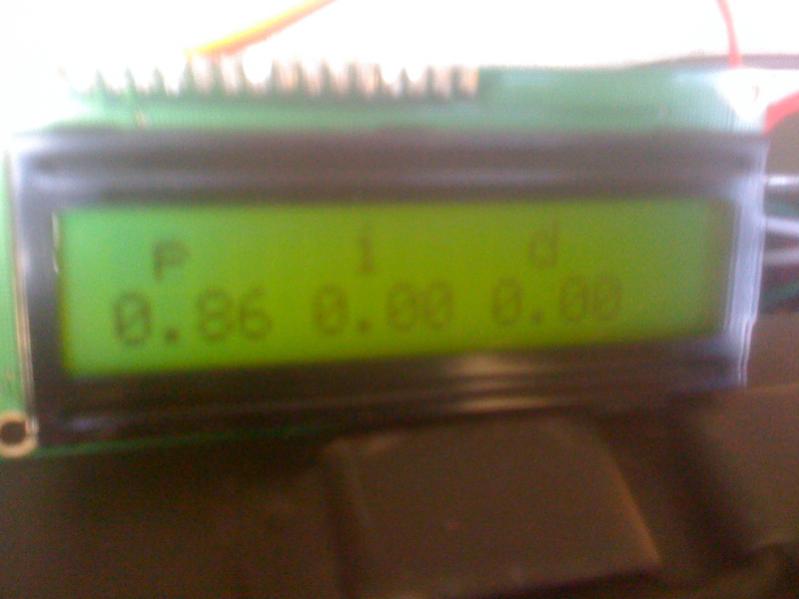#include <PID_v1.h>
#include <PID_AutoTune_v0.h>
#include <OneWire.h>
int DS18S20_Pin = 8; //DS18S20 Signal pin on digital 8
//Temperature chip i/o
OneWire ds(DS18S20_Pin); // on digital pin 8
#define RelayPin 3
int relayPin = 3;
int WindowSize = 1000;
unsigned long windowStartTime;
byte ATuneModeRemember=2;
double input=80, output=50, setpoint=100;
double kp=2,ki=0.5,kd=2;
double kpmodel=1.5, taup=100, theta[50];
double outputStart=5;
double aTuneStep=500, aTuneNoise=1, aTuneStartValue=500;
unsigned int aTuneLookBack=200;
boolean tuning = true;
unsigned long modelTime, serialTime;
PID myPID(&input, &output, &setpoint,kp,ki,kd, DIRECT);
PID_ATune aTune(&input, &output);
//set to false to connect to the real world
boolean useSimulation = false;
void setup()
{
//Setup the pid
myPID.SetOutputLimits(0, WindowSize);
myPID.SetMode(AUTOMATIC);
if(useSimulation)
{
for(byte i=0;i<50;i++)
{
theta[i]=outputStart;
}
modelTime = 0;
}
if(tuning)
{
tuning=false;
changeAutoTune();
tuning=true;
}
serialTime = 0;
Serial.begin(9600);
windowStartTime = millis(); //from pid test Relay
pinMode(RelayPin,OUTPUT); //from pid test Relay
}
void loop()
{
unsigned long now = millis();
float temperature = getTemp();
float tempF = temperature * 9/5 + 32;
if(!useSimulation)
{ //pull the input in from the real world
input = tempF;
}
if(tuning)
{
byte val = (aTune.Runtime());
if (val!=0)
{
tuning = false;
}
if(!tuning)
{ //we're done, set the tuning parameters
kp = aTune.GetKp();
ki = aTune.GetKi();
kd = aTune.GetKd();
myPID.SetTunings(kp,ki,kd);
AutoTuneHelper(false);
}
}
else myPID.Compute();
if(useSimulation)
{
theta[30]=output;
if(now>=modelTime)
{
modelTime +=100;
DoModel();
}
}
else
{
// analogWrite(0,output); // commented out by me
unsigned long now = millis();
if(now - windowStartTime>WindowSize)
{ //time to shift the Relay Window
windowStartTime += WindowSize;
}
if(output > now - windowStartTime) digitalWrite(RelayPin,HIGH);
else digitalWrite(RelayPin,LOW);
}
//send-receive with processing if it's time
if(millis()>serialTime)
{
SerialReceive();
SerialSend();
serialTime+=1000;
}
}
void changeAutoTune()
{
if(!tuning)
{
//Set the output to the desired starting frequency.
output=aTuneStartValue;
aTune.SetNoiseBand(aTuneNoise);
aTune.SetOutputStep(aTuneStep);
aTune.SetLookbackSec((int)aTuneLookBack);
AutoTuneHelper(true);
tuning = true;
}
else
{ //cancel autotune
aTune.Cancel();
tuning = false;
AutoTuneHelper(false);
}
}
void AutoTuneHelper(boolean start)
{
if(start)
ATuneModeRemember = myPID.GetMode();
else
myPID.SetMode(ATuneModeRemember);
}
void SerialSend()
{
Serial.print("setpoint: ");Serial.print(setpoint); Serial.print(" ");
Serial.print("input: ");Serial.print(input); Serial.print(" ");
Serial.print("output: ");Serial.print(output); Serial.print(" ");
if(tuning){
Serial.println(" tuning mode ");
// Serial.print("kp: ");Serial.print(myPID.GetKp());Serial.print(" ");
// Serial.print("ki: ");Serial.print(myPID.GetKi());Serial.print(" ");
// Serial.print("kd: ");Serial.print(myPID.GetKd());Serial.println();
} else {
Serial.print("kp: ");Serial.print(myPID.GetKp());Serial.print(" ");
Serial.print("ki: ");Serial.print(myPID.GetKi());Serial.print(" ");
Serial.print("kd: ");Serial.print(myPID.GetKd());Serial.println();
}
}
void SerialReceive()
{
if(Serial.available())
{
char b = Serial.read();
Serial.flush();
if((b=='1' && !tuning) || (b!='1' && tuning))changeAutoTune();
}
}
void DoModel()
{
//cycle the dead time
for(byte i=0;i<49;i++)
{
theta[i] = theta[i+1];
}
//compute the input
input = (kpmodel / taup) *(theta[0]-outputStart) + input*(1-1/taup) + ((float)random(-10,10))/100;
}
float getTemp(){
//returns the temperature from one DS18S20 in DEG Celsius
byte data[12];
byte addr[8];
if ( !ds.search(addr)) {
//no more sensors on chain, reset search
ds.reset_search();
return -1000;
}
if ( OneWire::crc8( addr, 7) != addr[7]) {
Serial.println("CRC is not valid!");
return -1000;
}
if ( addr[0] != 0x10 && addr[0] != 0x28) {
Serial.print("Device is not recognized");
return -1000;
}
ds.reset();
ds.select(addr);
ds.write(0x44,1); // start conversion, with parasite power on at the end
byte present = ds.reset();
ds.select(addr);
ds.write(0xBE); // Read Scratchpad
for (int i = 0; i < 9; i++) { // we need 9 bytes
data[i] = ds.read();
}
ds.reset_search();
byte MSB = data[1];
byte LSB = data[0];
float tempRead = ((MSB << 8) | LSB); //using two's compliment
float TemperatureSum = tempRead / 16;
return TemperatureSum;
}









































![Craft A Brew - Safale S-04 Dry Yeast - Fermentis - English Ale Dry Yeast - For English and American Ales and Hard Apple Ciders - Ingredients for Home Brewing - Beer Making Supplies - [1 Pack]](https://m.media-amazon.com/images/I/41fVGNh6JfL._SL500_.jpg)




















